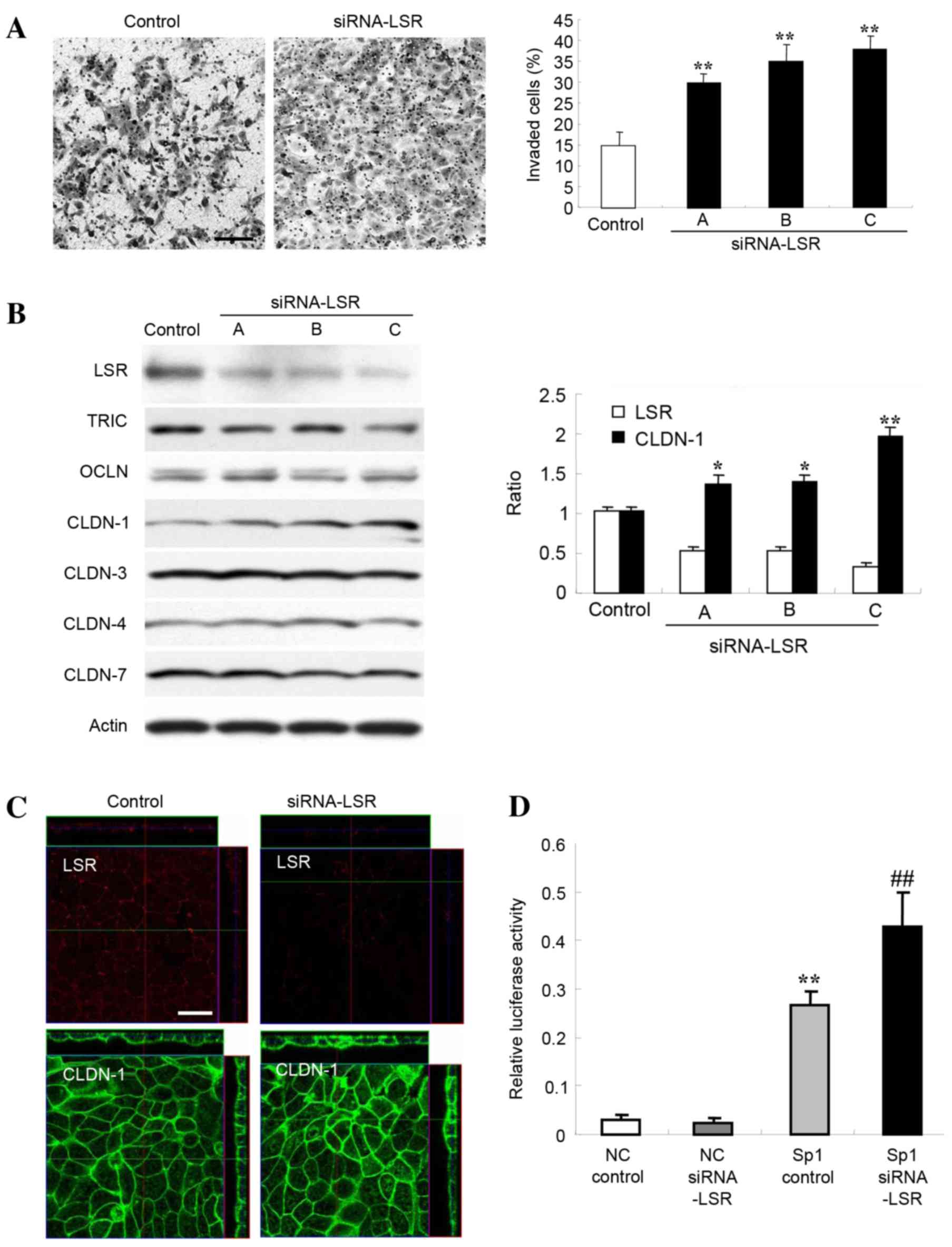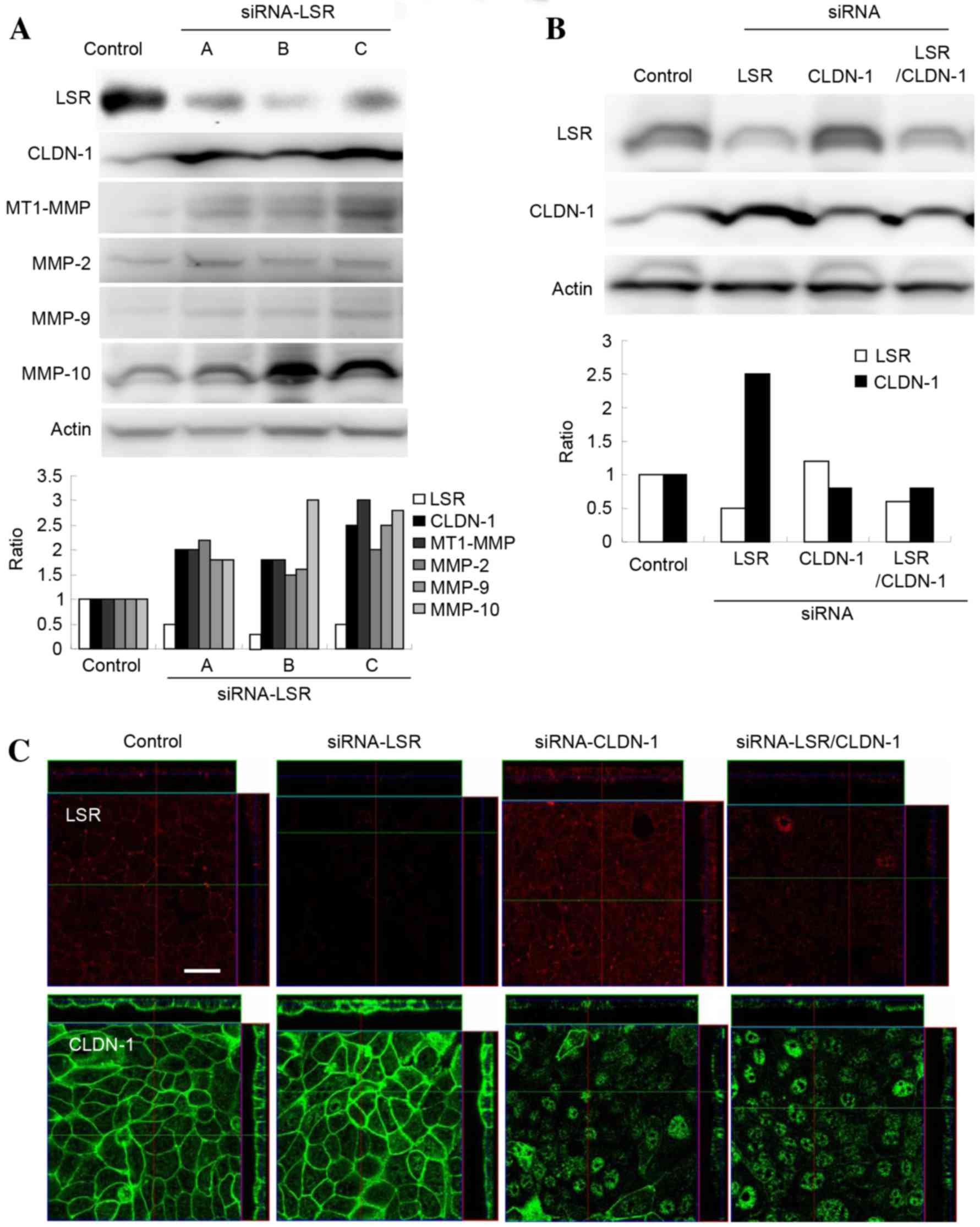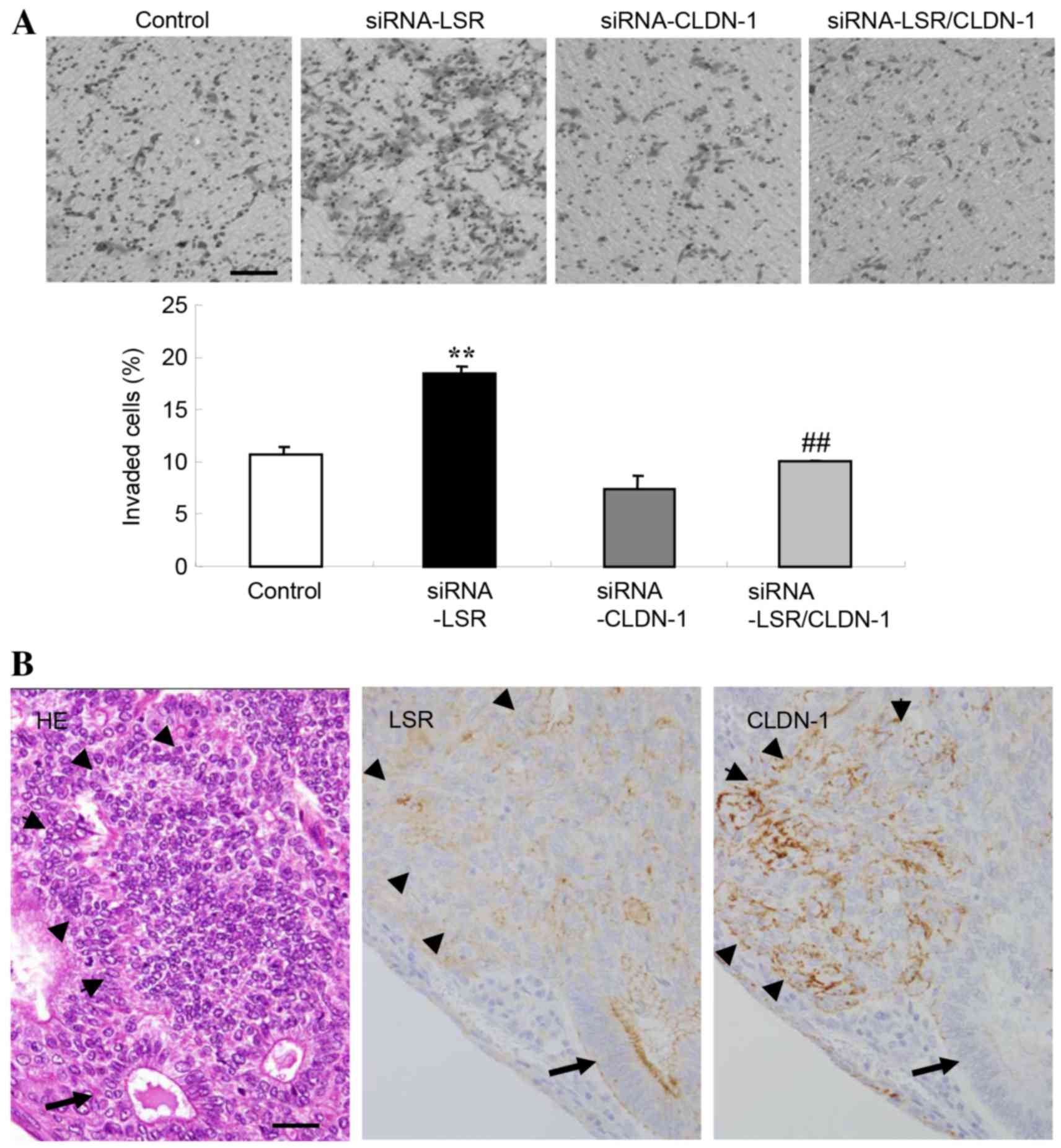|
1
|
Ikenouchi J, Furuse M, Furuse K, Sasaki H
and Tsukita S and Tsukita S: Tricellulin constitutes a novel
barrier at tricellular contacts of epithelial cells. J Cell Biol.
171:939–945. 2005. View Article : Google Scholar : PubMed/NCBI
|
|
2
|
Masuda S, Oda Y, Sasaki H, Ikenouchi J,
Higashi T, Akashi M, Nishi E and Furuse M: LSR defines cell corners
for tricellular tight junction formation in epithelial cells. J
Cell Sci. 124:548–555. 2011. View Article : Google Scholar : PubMed/NCBI
|
|
3
|
Matter K and Balda MS: Signaling to and
from tight junctions. Nat Rev Mol Cell Biol. 4:225–236. 2003.
View Article : Google Scholar : PubMed/NCBI
|
|
4
|
Tsukita S, Yamazaki Y, Katsuno T, Tamura A
and Tsukita S: Tight junction-based epithelial microenvironment and
cell proliferation. Oncogene. 27:6930–6938. 2008. View Article : Google Scholar : PubMed/NCBI
|
|
5
|
Martin TA and Jiang WG: Loss of tight
junction barrier function and its role in cancer metastasis.
Biochim Biophys Acta. 1788:872–891. 2009. View Article : Google Scholar : PubMed/NCBI
|
|
6
|
Martin TA: The role of tight junctions in
cancer metastasis. Semin Cell Dev Biol. 36:224–231. 2014.
View Article : Google Scholar : PubMed/NCBI
|
|
7
|
Li X, Li Y, Qiu H and Wang Y:
Downregulation of claudin-7 potentiates cellular proliferation and
invasion in endometrial cancer. Oncol Lett. 6:101–105.
2013.PubMed/NCBI
|
|
8
|
Leech AO, Cruz RG, Hill AD and Hopkins AM:
Paradigms lost-an emerging role for over-expression of tight
junction adhesion proteins in cancer pathogenesis. Ann Transl Med.
3:1842015.PubMed/NCBI
|
|
9
|
Oku N, Sasabe E, Ueta E, Yamamoto T and
Osaki T: Tight junction protein claudin-1 enhances the invasive
activity of oral squamous cell carcinoma cells by promoting
cleavage of laminin-5 gamma2 chain via matrix metalloproteinase
(MMP)-2 and membrane-type MMP-1. Cancer Res. 66:5251–5257. 2006.
View Article : Google Scholar : PubMed/NCBI
|
|
10
|
Leotlela PD, Wade MS, Duray PH, Rhode MJ,
Brown HF, Rosenthal DT, Dissanayake SK, Earley R, Indig FE,
Nickoloff BJ, et al: Claudin-1 overexpression in melanoma is
regulated by PKC and contributes to melanoma cell motility.
Oncogene. 26:3846–3856. 2007. View Article : Google Scholar : PubMed/NCBI
|
|
11
|
Kondoh A, Takano K, Kojima T, Ohkuni T,
Kamekura R, Ogasawara N, Go M, Sawada N and Himi T: Altered
expression of claudin-1, claudin-7 and tricellulin regardless of
human papilloma virus infection in human tonsillar squamous cell
carcinoma. Acta Otolaryngol. 131:861–868. 2011. View Article : Google Scholar : PubMed/NCBI
|
|
12
|
Patonai A, Erdélyi-Belle B, Korompay A,
Somorácz A, Straub BK, Schirmacher P, Kovalszky I, Lotz G, Kiss A
and Schaff Z: Claudins and tricellulin in fibrolamellar
hepatocellular carcinoma. Virchows Arch. 458:679–688. 2011.
View Article : Google Scholar : PubMed/NCBI
|
|
13
|
Korompay A, Borka K, Lotz G, Somorácz A,
Törzsök P, Erdélyi-Belle B, Kenessey I, Baranyai Z, Zsoldos F,
Kupcsulik P, et al: Tricellulin expression in normal and neoplastic
human pancreas. Histopathology. 60:E76–E86. 2012. View Article : Google Scholar : PubMed/NCBI
|
|
14
|
Masuda R, Semba S, Mizuuchi E, Yanagihara
K and Yokozaki H: Negative regulation of the tight junction protein
tricellulin by snail-induced epithelial-mesenchymal transition in
gastric carcinoma cells. Pathobiology. 77:106–113. 2010. View Article : Google Scholar : PubMed/NCBI
|
|
15
|
Herbsleb M, Birkenkamp-Demtroder K,
Thykjaer T, Wiuf C, Hein AM, Orntoft TF and Dyrskjøt L: Increased
cell motility and invasion upon knockdown of lipolysis stimulated
lipoprotein receptor (LSR) in SW780 bladder cancer cells. BMC Med
Genomics. 1:312008. View Article : Google Scholar : PubMed/NCBI
|
|
16
|
Reaves DK, Fagan-Solis KD, Dunphy K,
Oliver SD, Scott DW and Fleming JM: The role of lipolysis
stimulated lipoprotein receptor in breast cancer and directing
breast cancer cell behavior. PLoS One. 9:e917472014. View Article : Google Scholar : PubMed/NCBI
|
|
17
|
Kurman RJ, Carcangiu ML, Herrington CS and
Young RH: WHO Classification of tumours of Female Reproductive
Organs. 4th. Lyon, France: International Agency for Research on
Cancer; 2014
|
|
18
|
Wang HB, Wang PY, Wang X, Wan YL and Liu
YC: Butyrate enhances intestinal epithelial barrier function via
up-regulation of tight junction protein Claudin-1 transcription.
Dig Dis Sci. 57:3126–3135. 2012. View Article : Google Scholar : PubMed/NCBI
|
|
19
|
Somorácz A, Korompay A, Törzsök P, Patonai
A, Erdélyi-Belle B, Lotz G, Schaff Z and Kiss A: Tricellulin
expression and its prognostic significance in primary liver
carcinomas. Pathol Oncol Res. 20:755–764. 2014. View Article : Google Scholar : PubMed/NCBI
|
|
20
|
Süren D, Yıldırım M, Kaya V, Alikanoğlu
AS, Bülbüller N, Yıldız M and Sezer C: Loss of tight junction
proteins (Claudin 1, 4 and 7) correlates with aggressive behavior
in colorectal carcinoma. Med Sci Monit. 20:1255–1262. 2014.
View Article : Google Scholar : PubMed/NCBI
|
|
21
|
Khan N and Asif AR: Transcriptional
regulators of claudins in epithelial tight junctions. Mediators
Inflamm. 2015:2198432015. View Article : Google Scholar : PubMed/NCBI
|
|
22
|
Romero-Pérez L, Garcia-Sanz P, Mota A,
Leskelä S, Hergueta-Redondo M, Díaz-Martín J, López-García MA,
Castilla MA, Martínez-Ramírez A, Soslow RA, et al: A role for the
transducer of the Hippo pathway, TAZ, in the development of
aggressive types of endometrial cancer. Mod Pathol. 28:1492–1503.
2015. View Article : Google Scholar : PubMed/NCBI
|
|
23
|
Moleirinho S, Guerrant W and Kissil JL:
The Angiomotins-from discovery to function. FEBS Lett.
588:2693–2703. 2014. View Article : Google Scholar : PubMed/NCBI
|

















